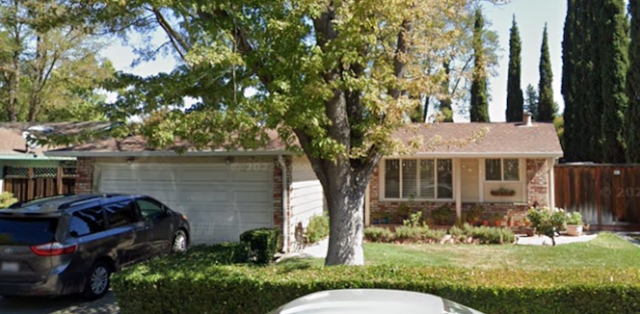Inside Amador Estates: sunshine, happiness, and 38 minutes to the City
A historical tour of Amador Estates, Pleasanton (1964–1966)
Explore Amador Estates in Pleasanton through vintage 1964–1966 newspaper ads and see what the original model homes look like today. A curated archive for fans of 1960s–70s architecture, suburban design, and East Bay history.
Welcome to Amador Estates, 1964–1966
In the golden summer of 1964, a modest neighborhood in Pleasanton opened its doors—and its sun-filled windows—to a world of hopeful new homeowners. Amador Estates, a charming development by DevMar, offered the kind of lifestyle that urban dwellers only dreamed of: clean air, open skies, and a commute that boasted just one stop between your driveway and downtown San Francisco.
 |
| Location of the Amador Estates neighborhood in Pleasanton, California. |
And if that wasn’t enough, it came wrapped in a cheerful new slogan: “Live in the Sunshine Belt!”
 |
| Ad for Amador Estates from August 16, 1964. |
Escaping the smog, embracing the sun
In the mid-60s, city life had started to lose its shine. As cars multiplied and smog settled over Bay Area skylines, many families looked east—for bluer skies and breathing room. Enter Pleasanton, a then-sleepy town with a name that sounded like a promise. And nestled right in the heart of it, Amador Estates was calling.
With prices starting at just $16,500—the lowest in the area—the value was undeniable. But the real sell? Sunshine. Happiness. Easy freeway access. These weren’t just amenities; they were the new luxuries of modern living.
 |
| From a 1964 Oakland Tribune ad—teasing the joy of being as happy as a little girl with a banjo. In 1964, that was practically an aspirational lifestyle brand. |
A perfect place, perfectly placed
While other suburban tracts were springing up in the middle of nowhere, Amador Estates got the geography right. Yes, the freeway (then still called Highway 50, soon to become I-580) made commuting west a breeze. But even better? You didn’t need to drive much at all.
Schools? A short walk away.
Shopping? Right around the corner.
Parks, playgrounds, downtown Pleasanton? Practically on your doorstep.
It was the best of both worlds—a peaceful, residential escape with urban convenience baked in. And for growing families? It hit every mark.
 |
| From a 1966 Oakland Tribune ad—with a new freeway in place, just 38 minutes from your home to work in San Francisco. Ah, the good ole days. |
The original Amador Estates model homes
DevMar initially launched with three model homes on the Santa Rita Road frontage street, each tailored to meet the practical needs—and stylish dreams—of mid-century buyers. A fourth joined the lineup in 1965.
 |
| Site of the Amador Estates model homes. |
Pricing history
1964: $16,500 +
1965 (second unit): $16,700 +
1965 (third unit): $16,300 - $19,300
1966: $16,300 - $19,300
1. The Candia (Plan 200)
3 bedrooms, 2 bathrooms, 1,236 sq. ft. A balanced and bright layout, the Candia was designed for function and flow. Families loved its efficient footprint and welcoming curb appeal.
 |
| A Candia home (not original model). |
 |
| The floor plan of the Candia. |
2. The Carousel (Plan 100)
3 bedrooms, 2 bathrooms, 1,159 sq. ft. With a name like Carousel, you expect a bit of fun—and this model delivered. Open-concept for its time, it brought natural light into every corner and felt surprisingly spacious
 |
| The original Carousel model today. |
3. The Colleen (Plan 300)
4 bedrooms, 2 bathrooms, 1,368 sq. ft. The largest of the models, the Colleen offered room to grow, with a fourth bedroom that often became a den, TV room, or at-home office.
 |
| The original Colleen model today. |
4. The Calico (Plan 400)
3 bedrooms, 2 bathrooms, 1,104 sq. ft. A 1965 addition to the lineup, the Calico was compact and cost-conscious—but still every bit a Pleasanton home. It featured a carport, which almost every owner has since turned into a garage.
 |
| The original Calico model today. |
 |
| The floor plan for the Calico. |
Still golden after all these years
Yes, these homes were small by today’s standards. But in the age of one car, one breadwinner, and one black-and-white TV, they were more than enough. Sales wrapped up in 1966, and Amador Estates carved out a beloved niche in Pleasanton’s history. Many of the original homes have since been modified, expanded, and lovingly maintained—but the bones remain, and so does the unbeatable location.
Today, homeowners still enjoy:
- Walking distance to Amador Valley High, Alisal Elementary, and Amador Valley Community Park
- Quick trips to downtown Pleasanton
- Proximity to shopping, dining, and business hubs
In short, location still wins—just as it did in 1964.
Legacy of light
Amador Estates may not be flashy. Its homes were modest, its streets quiet. But for those first families—drawn by sunshine, happiness, and the promise of something better—it was everything.
A commute to the city. A kitchen filled with morning sun. A swing set under a blue sky.
It was the Sunshine Belt dream—and for many, it still is.





Comments
Post a Comment